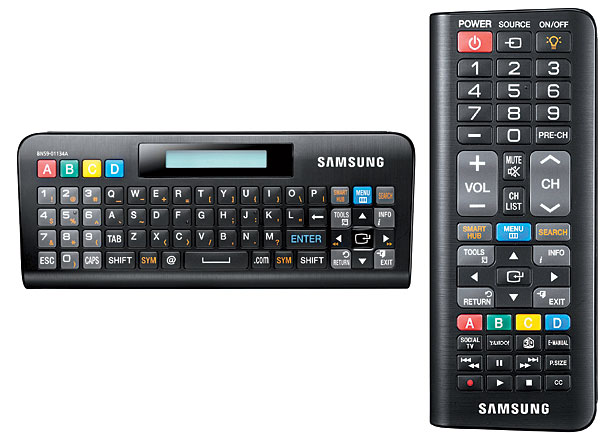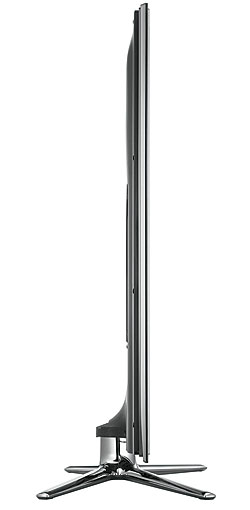Samsung PN59D8000 3D Plasma HDTV Page 2
2D Performance
The PN59D8000 sailed through all of our standard high-definition video processing tests (see the Video Test Bench). It also passed 480i-to-1080p deinterlacing tests.

The Samsung’s 2D color and resolution were hard to fault. Before calibration, the image in the warm2 color tone (color temperature) setting was a little too red, although not so much as to look obviously off to the average viewer. The colors were convincing and never looked wrong. A good calibration produced a near-ideal result (see HT Labs Measures). Fleshtones were spot on. Greens looked believable. Reds were as vivid as they needed to be, but no more. I had no complaints.
Same for the set’s resolution. Details were solidly reproduced, but not over-enhanced. A little noise was visible in large areas of solid color when viewed from very close to the screen, but that’s common in plasmas. It wasn’t an issue from a normal viewing distance.
The screen was as reflective as most of today’s HDTVs. When the set is off in a well-lit room, you will see reflections. Avoid placing the Samsung where room lights and/or windows are likely to reflect directly off the screen. The set’s rotating stand and (like all plasmas) superb offaxis performance will both help with this.
Interestingly, the screen would drop to total black on a fadeout, much like a local-dimming LED/LCD set and not always at predictable times. But let even the smallest bright area, such as the pause bug from a Blu-ray player, intrude into that total blackness, and the entire screen increases to what I consider to be its true, usable level—a level that’s good but not exceptional (see HT Labs Measures). While the set’s black levels and shadow detail were never jaw dropping, they weren’t disappointing, either. Black letterbox bars on 2.35:1 films were barely visible and well below annoyance level. 2D images rarely looked grayish, muddled, or crushed—as they sometimes do on LCD sets.
 3D Viewing
3D Viewing
With one exception, the Samsung’s 3D performance was impeccable. That exception, no surprise, was image brightness. Brightness is an issue on most 3D sets but particularly on plasmas, which are inherently dimmer than LCD designs. There’s a limit to how hard you can push a plasma’s peak output before problems arise.
But as with most 3D sets I’ve tested, the eyes adjust remarkably well to a dim picture. When you put on the 3D glasses, your first thought is that this just won’t do. But soon, following both the adjustment of your eyes’ pupils and simple acclimatization to the new brightness level, it’s often easy to forget that the picture is a fraction of the brightness of a 2D picture. It helps to keep the room lights as dim as possible, and not go back and forth between 2D and 3D in the same sitting. Thankfully, most of the 3D releases we have are bright and cheery animated fare, such as Tangled, which looked terrific on the Samsung.
I stuck with the Movie mode for 3D, with some minor adjustments in the standard video controls. The dynamic mode was the only other mode that offered a possibly useful increase in brightness. But that mode involved other tradeoffs, including a less than full complement of video controls.
Samsung uses the same low-gamma trick here that we observed in the newest Panasonic plasmas. A low gamma pumps up the image in the mid-brightness region but can also make it difficult to get consistent video quality from scene to scene as the average brightness level varies. Fortunately, the latter problem was relatively rare here. Bright scenes, such as those in Tangled, looked good. The night scenes in Avatar, particularly early on in the forest as Jake’s avatar battles viper wolves, and later as he moves through the luminous foliage, were certainly dark but exceptionally realistic, with good shadow detail.
The Samsung’s 3D image was also sharp and completely free of visible ghosting. The 3D effects were maintained even well off axis. When I moved my head at any conceivable angle, I didn’t notice either ghosting or image dimming. Before calibration, the 3D color didn’t measure particularly well, but it looked acceptable. It was much improved after calibration, although only the two-point white balance controls are accessible in 3D. The color space custom mode controls can’t be adjusted separately for both 2D and 3D. The 2D custom settings for 3D didn’t work well, so for 3D, I set color space to its auto setting, which did.
Comparisons
I compared the Samsung directly to the Panasonic Viera TCP55VT30 I reviewed in the September issue. Because the sets use different glasses, I had to limit my 3D comparison to a check of subjective brightness, where the result was largely a toss-up. Both sets were significantly dimmer in 3D than LCD designs such as the Sony XBR-55HX929 (Home Theater, November 2011).
With both the Panasonic and the Samsung adjusted to look as identical as possible while still maintaining a proper setup, the differences between them were surprisingly subtle. The Panasonic’s black level was lower, but this was as visibly marginal as the measured results might suggest (0.006 ft-L on the Panasonic, 0.009 ft-L on the Samsung). Nevertheless, I could see a difference in the Panasonic’s favor on the most difficult material.
The Samsung’s color was a bit warmer, but adjustments to the Panasonic’s tint control almost balanced that out. In particular, naturally photographed fleshtones looked convincing on both sets, though not absolutely identical.
After calibration, the differences in the two sets boiled down to very slightly better blacks on the Panasonic. That’s about it. Beyond that, you can decide between these sets based on price, features, and the availability of the screen size you prefer.
Conclusions
Apart from a somewhat dim 3D image (an issue shared by other plasma models we’ve tested), this Samsung is a superb HDTV. It has one of the best feature sets on the market, particularly the flexibility of its color calibration. Its Internet features (if that’s your thing) are among the best out there. It won’t disappoint. Highly recommended.













































